THE LIVING WORLD
Unit Six. Animal Life
31. Reproduction and Development
31.3. Males
The human male gamete, or sperm, is highly specialized for its role as a carrier of genetic information. Produced after meiosis, sperm cells have 23 chromosomes instead of the 46 found in other cells of the male body. Sperm do not successfully complete their development at 37°C (98.6°F), the normal human body temperature. The sperm-producing organs, the testes (singular, testis), move during the course of fetal development into a sac called the scrotum (figure 31.11), which hangs between the legs of the male, maintaining the two testes at a temperature about 3°C cooler than the rest of the body. The testes contain cells that secrete the male sex hormone testosterone.
Male Gametes Are Formed in the Testes
An internal view of the testes in figure 31.12 1 shows that they are composed of several hundred compartments, each packed with large numbers of tightly coiled tubes called seminiferous tubules (seen in cross section in 2). Sperm production, spermatogenesis, takes place inside the tubules. The process of spermatogenesis begins in germinal cells toward the outside of the tubule (shown in the enlarged view in 3). As the cells undergo meiosis, they move toward the lumen of the tubule 4, with spermatozoa being released into the tubule 5. The number of sperm produced is truly incredible. A typical adult male produces several hundred million sperm each day of his life! Those that are not ejaculated from the body are broken down, and their materials are reabsorbed and recycled.
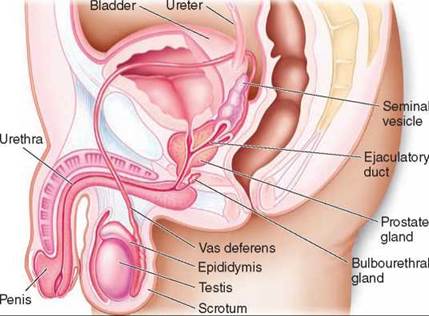
Figure 31.11. The male reproductive organs.
The testis is where sperm are formed. Cupped above the testis is the epididymis, a highly coiled passageway within which sperm complete their maturation. Extending away from the epididymis is a long tube, the vas deferens.
After a sperm cell is manufactured within the testes through intermediate stages of meiosis, it is delivered to a long, coiled tube called the epididymis (see figure 31.12), where it matures. A sperm cell is not motile when it arrives in the epididymis, and it must remain there for at least 18 hours before its motility develops. Mature sperm are relativ simple cells, consisting of a head, body, and tail (figure 31.13). The head encloses a compact nucleus and is capped by a vesicle called an acrosome. The acrosome contains enzymes that aid in the penetration of the protective layers surrounding the egg. The body and tail provide a propulsive mechanism: Within the tail is a flagellum, and inside the body are centrioles, which act as a basal body for the flagellum, and mitochondria, which generate the energy needed for flagellar movement.
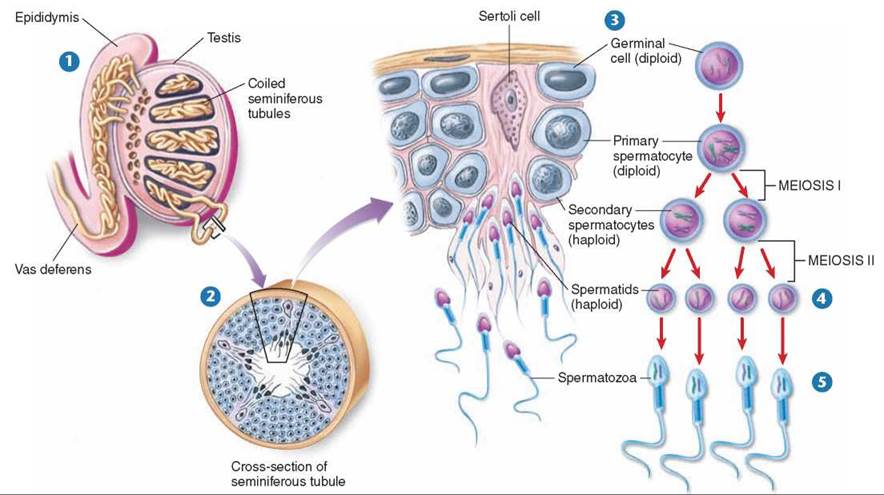
Figure 31.12. The testis and formation of sperm.
Inside the testis 1, the seminiferous tubules 2 are the sites of sperm formation. Germinal cells in the seminiferous tubules 3 give rise to primary spermatocytes (diploid), which undergo meiosis to form haploid spermatids 4. Spermatids develop into mobile spermatozoa, or sperm 5. Sertoli cells are nongerminal cells within the walls of the seminiferous tubules. They assist spermatogenesis in several ways, such as helping to convert spermatids into spermatozoa.
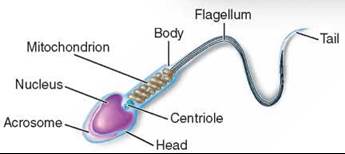
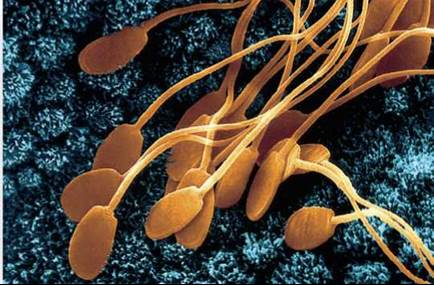
Figure 31.13. Human sperm cells.
Each sperm possesses a long tail that propels the sperm and a head that contains the nucleus. The tip, or acrosome, contains enzymes to help the sperm cell digest a passageway into the egg for fertilization.
From the epididymis, the sperm is delivered to another long tube, the vas deferens. When sperm are released during intercourse, they travel through a tube from the vas deferens to the urethra, where the reproductive and urinary tracts join, emptying through the penis. Sperm is released in a fluid called semen, which also contains secretions mostly from the seminal vesicles and the prostate gland that provide metabolic energy sources for the sperm. Benign enlargement of the prostate occurs in 90% of men by age 70, but it can be cancerous. Prostate cancer is the second most common cancer in men and can be treated effectively if detected early during physical examinations before it spreads.
Male Gametes Are Delivered by the Penis
In the case of humans and some other mammals, the penis is an external tube containing two long cylinders of spongy tissue side by side (seen in cross section in figure 31.14). Below and between them runs a third cylinder of spongy tissue that contains in its center the urethra, through which both semen (during ejaculation) and urine (during urination) pass. Why this unusual design? The penis is designed to inflate. The spongy tissues that make up the three cylinders are riddled with small spaces between the cells, and when nerve impulses from the CNS cause the arterioles leading into this tissue to expand, blood collects within these spaces. Like blowing up a balloon, this causes the penis to become erect and rigid. Continued stimulation by the CNS is required for erection to continue.
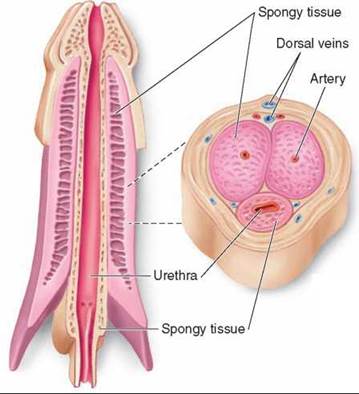
Figure 31.14. Structure of the penis.
(Left) longitudinal section; (right) cross section.
Erection can be achieved without any physical stimulation of the penis, but physical stimulation is required for semen to be delivered. Stimulation of the penis, as by repeated thrusts into the vagina of a female, leads first to the mobilization of the sperm. In this process, muscles encircling the vas deferens contract, moving the sperm along the vas deferens into the urethra. The bulbourethral glands also secrete a clear, slippery fluid that neutralizes the acidity of any residual urine and lubricates the head of the penis. Further penis stimulation then leads to the strong contraction of the muscles at the base of the penis. The result is ejaculation, the forceful ejection of 2 to 5 milliliters of semen. Within this small 5-milliliter volume are several hundred million sperm. Because the odds against any one individual sperm cell successfully completing the long journey to the egg and fertilizing it are extraordinarily high, successful fertilization requires a high sperm count. Males with fewer than 20 million sperm per milliliter are generally considered sterile.
Key Learning Outcome 31.3. Male testes continuously produce large numbers of male gametes, sperm, which mature in the epididymis, are stored in the vas deferens, and are delivered through the penis into the female.